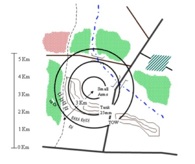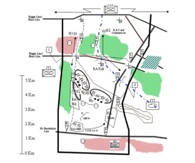Tactics 101: 030 – Planning the Defense
Before we continue, we must stress that this technique is just that — a technique. It is a way to position weapon systems to assist in getting the most rounds into an engagement area as possible. Certainly, the more killing systems you can have accurately fire into an enemy formation the better!
The ability to fully incorporate this technique is obviously dependent on a wide array of variables. The principal variable is the terrain. The terrain must afford cover and concealment and good fields of fire for the short, medium, and long range weapon systems a commander has at his disposable. If the terrain does offer this potential there is no better way to concentrate a unit’s direct fire weapons at the right place and right time.
In discussing this concept, let’s first start with the point that not all fires will be targeted on this point. Other, less likely, avenues of approach must also be covered. Doctrine or no doctrine, the defender must remember that the enemy does not want to die. He will attempt to maneuver out of the “beaten zone” to bypass if possible. (If he does not, it is truly a good day!) Fires and forces must cover these avenues of approach in an economy of force role. With that said, let’s outline this technique.
{default} The commander begins by drawing a circle around the point where he has decided to defeat the enemy attack (this is his engagement area which he began analyzing earlier). Next he places concentric circles around this point, radiating from the point of maximum destruction. Each circle matches the maximum effective range of each of his systems, as if they were at the decisive point (marked as a target reference point), firing outward. For each system to reach into the “circle of death”, it must be placed along the perimeter of the circle. This helps the commander to select solid, relevant, positions.
The commander begins by drawing a circle around the point where he has decided to defeat the enemy attack (this is his engagement area which he began analyzing earlier). Next he places concentric circles around this point, radiating from the point of maximum destruction. Each circle matches the maximum effective range of each of his systems, as if they were at the decisive point (marked as a target reference point), firing outward. For each system to reach into the “circle of death”, it must be placed along the perimeter of the circle. This helps the commander to select solid, relevant, positions.
Additionally, the commander may need to lay down two or three more of these bullseyes to plan for secondary avenues of approach and to cover contingency plans. Once he is complete, his sketch should look something like the illustration at right.
The circular weapons positioning technique aids the commander in selecting good tentative positions based on a map recon. Each position and engagement area must be verified by physical ground recon to ensure accuracy.
Control Measures
 *Please see Article 10 of the series (Graphics) for explanation of the symbols used in this diagram. Tactics 101: 010. Graphics
*Please see Article 10 of the series (Graphics) for explanation of the symbols used in this diagram. Tactics 101: 010. Graphics
Once the commander has placed his “circles of death” to determine where to position his forces so that they can kill where he wants the enemy to die; he must then emplace control measures. Control measures are important in all operations and are perhaps, even more critical in the defense. A unit that does not possess sound control measures, understood by all, is setting the conditions for defeat. Poorly planned control measures lead to misuse of resources (particularly ammunition), make any changes during the heat of battle extremely difficult, and are a huge factor in fratricides on the battlefield.
All too often, inexperienced commanders place control measures on the map, then attempt to fit their weapon systems into the control measures. They then see if they can mass fires where they are needed. Wrong! First, decide where the enemy must die, allocate systems to focus fires on that point, and then establish your control measures.
[continued on next page]


mr sutherland(black 6) i would to talk to you about a unit that fought in desert storm. Bco 3/15 infantry. also about a driver that was said to be the best bradley driver ever produced by the US ARMY. let me know if you want to talk about tactics.
Armchair General staff cannot respond here. Please read
disclaimer just above this text box before posting.
Ozone! How are you? Are you still in? I seem to remember the
unit you’re talking about but I can’t remember a great driver. I
do remember a fairly mediocre driver who needed constant
supervision to keep his vehicle running!
Lets talk!